
Indians of Iowa
Encyclopedia
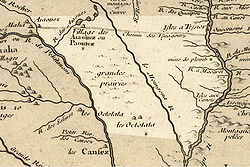
Indigenous peoples of the Americas
The indigenous peoples of the Americas are the pre-Columbian inhabitants of North and South America, their descendants and other ethnic groups who are identified with those peoples. Indigenous peoples are known in Canada as Aboriginal peoples, and in the United States as Native Americans...
tribes which have lived in the state of Iowa
Iowa
Iowa is a state located in the Midwestern United States, an area often referred to as the "American Heartland". It derives its name from the Ioway people, one of the many American Indian tribes that occupied the state at the time of European exploration. Iowa was a part of the French colony of New...
historically
History of Iowa
Although Native Americans have occupied what is now Iowa for 13,000 years, the written history of Iowa begins with the protohistoric accounts of Native Americans by explorers such as Marquette and Joliet in the 1680s. Until the early 19th century Iowa was occupied exclusively by Indians and a few...
and prehistorically
Iowa archaeology
The archaeology of Iowa is the study of the buried remains of human culture within the state of Iowa from the earliest prehistoric through the late historic periods. When the American Indians first arrived in what is now Iowa more than 13,000 years ago, they were hunters and gatherers living in a...
:
Chewerean-Siouan speaking tribes from the prehistoric period
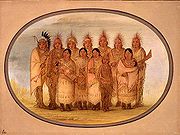
- Ho-ChunkHo-ChunkThe Ho-Chunk, also known as Winnebago, are a tribe of Native Americans, native to what is now Wisconsin and Illinois. There are two federally recognized Ho-Chunk tribes, the Ho-Chunk Nation of Wisconsin and Winnebago Tribe of Nebraska....
(Winnebago; often classified as Hochunk-Siouan speakers) - Ioway (Baxoje)
- Missouria
- Otos
The Chewerean tribes area probably descendant from the prehistoric Oneota
Oneota
Oneota is a designation archaeologists use to refer to a cultural complex that existed in the eastern plains and Great Lakes area of what is now the United States from around AD 900 to around 1650 or 1700. The culture is believed to have transitioned into various Macro-Siouan cultures of the...
, and appear to have been interconnected. At the time of contact with European explorers, their range covered most of Iowa. The Ho-Chunk ranged primarily east of the Mississippi in southern Wisconsin, the Ioway/Baxoje ranged in northern Iowa, the Otoe in central and southern Iowa, and the Missouria in far southern Iowa.
Dakotan-Siouan speakers from the prehistoric period
- Santee Sioux
- Yankton Sioux
The Dakota pushed southward into much of Iowa in the 18th and 19th century, and were commonly seen by settlers. In 1840, the translator Isaac Galland noted several Sioux groups in or near Iowa, including Wahpekute, North Sisseton, South Sisseton, East Wahpetonwan, West Wahpetonwan, Yankton, and Mdewakantonwan.
Dhegihan-Siouan speaking tribes which arrived in the late prehistoric period
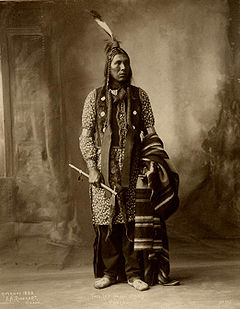
- KawKaw (tribe)The Kaw Nation are an American Indian people of the central Midwestern United States. The tribe known as Kaw have also been known as the "People of the South wind", "People of water", Kansa, Kaza, Kosa, and Kasa. Their tribal language is Kansa, classified as a Siouan language.The toponym "Kansas"...
(Kansa) - OmahaOmaha (tribe)The Omaha are a federally recognized Native American nation which lives on the Omaha Reservation in northeastern Nebraska and western Iowa, United States...
- OsageOsage NationThe Osage Nation is a Native American Siouan-language tribe in the United States that originated in the Ohio River valley in present-day Kentucky. After years of war with invading Iroquois, the Osage migrated west of the Mississippi River to their historic lands in present-day Arkansas, Missouri,...
- PoncaPoncaThe Ponca are a Native American people of the Dhegihan branch of the Siouan-language group. There are two federally recognized Ponca tribes: the Ponca Tribe of Nebraska and the Ponca Tribe of Indians of Oklahoma...
The Dhegiha lived near the Missouri in the very Late Prehistoric and historic periods; they appear to have migrated to the region from the south or southeast, their origin location is debated.
Other Siouan-language-speaking tibes of the late prehistoric period
- HidatsaHidatsaThe Hidatsa are a Siouan people, a part of the Three Affiliated Tribes. The Hidatsa's autonym is Hiraacá. According to the tribal tradition, the word hiraacá derives from the word "willow"; however, the etymology is not transparent and the similarity to mirahací ‘willows’ inconclusive...
- Mandan
These may be descendants of Late Prehistoric Mill Creek cultures whose range extended into northwest Iowa.
Caddoan-speaking tribes of the late prehistoric period

- ArikaraArikaraArikara are a group of Native Americans in North Dakota...
- Pawnee
These may be descendants of Late Prehistoric Central Plains Tradition cultures that lived in southwest Iowa, especially around the Glenwood
Glenwood, Iowa
Glenwood is a city in and the county seat of Mills County, Iowa, United States. The population was 5,269 in the 2010 census, a decline from 5,358 in the 2000 census. -History:...
area. The Pawnee (Panis) are shown in southwest Iowa in a 1798 map, although they ranged primarily to the west.
Algonquian speakers from the early historical period
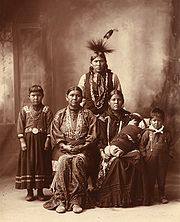
- Illinois Confederacy (including MoingonaMoingonaThe historic Miami-Illinois people who are today referred to as the Moingona or Moingwena were close allies of or perhaps part of the Peoria. They were assimilated by that tribe and lost their separate identity about 1700...
, PeoriaPeoria (tribe)The Peoria people are a Native American tribe. Today they are enrolled in the federally recognized Peoria Tribe of Indians of Oklahoma. Historically, they were part of the Illinois Confederation.-History:...
, Piankashaw) - Kickapoo
- Lenni Lenape (Delaware)
- MascoutenMascoutenThe Mascouten were a tribe of Algonquian-speaking native Americans who are believed to have dwelt on both sides of the Mississippi River adjacent to the present-day Wisconsin-Illinois border....
- MeskwakiMeskwakiThe Meskwaki are a Native American people often known to outsiders as the Fox tribe. They have often been closely linked to the Sauk people. In their own language, the Meskwaki call themselves Meshkwahkihaki, which means "the Red-Earths." Historically their homelands were in the Great Lakes region...
(Fox) - MiamiMiami tribeThe Miami are a Native American nation originally found in what is now Indiana, southwest Michigan, and western Ohio. The Miami Tribe of Oklahoma is the only federally recognized tribe of Miami Indians in the United States...
- Sauk
- WeaWeaThe Wea were a Miami-Illinois-speaking tribe originally located in western Indiana, closely related to the Miami. The name Wea is used today as the a shortened version of their many recorded names...
The encroachment of Europeans and long-term conflict among Algonquian and Iroquian tribes in the east pushed many eastern tribes into the Midwest. The Meskwaki have maintained a presence in Iowa, even after official removal in 1846, ultimately establishing a recognized Settlement
Meskwaki Settlement, Iowa
The Meskwaki Settlement is an unincorporated community in Tama County, Iowa, United States, west of Tama. It is often called "the Sett" by residents. It is home to a sizable community of Meskwaki Indians, enrolled in the Sac and Fox Tribe of the Mississippi in Iowa, who maintain a tribal school,...
.
Iroquoian speakers from the early historical period
- Wyandot (Huron)
Again, the encroachment of Europeans and long-term conflict between Algonquian and Iroquian tribes in the east pushed these tribes into the Midwest.
Moved into Iowa in the historical period
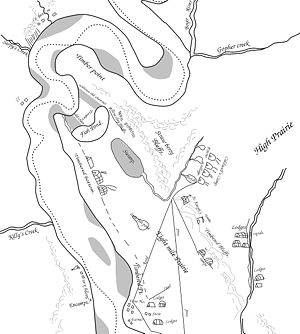
- PotawatomiPotawatomiThe Potawatomi are a Native American people of the upper Mississippi River region. They traditionally speak the Potawatomi language, a member of the Algonquian family. In the Potawatomi language, they generally call themselves Bodéwadmi, a name that means "keepers of the fire" and that was applied...
- Ojibwe (Chippewa)
- OdawaOdawa peopleThe Odawa or Ottawa, said to mean "traders," are a Native American and First Nations people. They are one of the Anishinaabeg, related to but distinct from the Ojibwe nation. Their original homelands are located on Manitoulin Island, near the northern shores of Lake Huron, on the Bruce Peninsula in...
(Ottawa)
Forced relocation of tribes in the 19th century led to eastern tribes living in and near Iowa. Potawatomi Chief Sauganash
Sauganash
Billy Caldwell, baptized Thomas Caldwell , known also as Sauganash, was a British-Mohawk fur trader who was commissioned captain in the Indian Department of Canada...
founded the village that eventually grew into Council Bluffs
Council Bluffs, Iowa
Council Bluffs, known until 1852 as Kanesville, Iowathe historic starting point of the Mormon Trail and eventual northernmost anchor town of the other emigrant trailsis a city in and the county seat of Pottawattamie County, Iowa, United States and is on the east bank of the Missouri River across...
.
Notable Indians who lived in Iowa
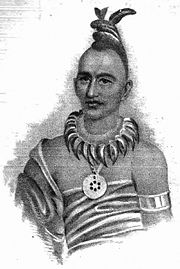
- AppanooseAppanooseAppanoose was a 19th century Meskwaki chief who lived in Iowa; he was son of Taimah and therefore probably a grandson of Quashquame.Several place names are ultimately derived from Appanoose:*Appanoose County, Iowa*Appanoose County Courthouse...
- Antonine BaradaAntonine BaradaAntonine Barada , alternatively spelled Antoine Barada, was an American folk hero in the state of Nebraska; son of an Omaha mother, he was also called Mo shi-no pazhi in the tribal language...
(White Horse) - Black HawkBlack Hawk (chief)Black Hawk was a leader and warrior of the Sauk American Indian tribe in what is now the United States. Although he had inherited an important historic medicine bundle, he was not one of the Sauk's hereditary civil chiefs...
- InkpadutaInkpadutaInkpaduta was a war chief of the Santee Sioux during the 1857 Spirit Lake Massacre and the 1862 Dakota War against the United States Army in Minnesota and the Dakota Territory.-Early life:Inkpaduta was born in what later became the Dakota...
- KeokukKeokuk (Sauk chief)Keokuk was a chief of the Sauk or Sac tribe in central North America noted for his policy of cooperation with the U.S. government which led to conflict with Black Hawk, who led part of their band into the Black Hawk War...
- MahaskaChief MahaskaMahaska , or White Cloud, was a chief of the Native American Iowa tribe.-Early life and education:Mahaska was born into the Iowa tribe...
- NeapopeNeapopeNeapope was a spiritual leader of the Sauk tribe and advisor to Black Hawk during the Black Hawk War.-Biography:...
- Maria PearsonMaria PearsonMaria Darlene Pearson was a Yankton Sioux activist who successfully challenged the legal treatment of Native American human remains. She was one of the primary catalysts for the creation of the Native American Graves Protection and Repatriation Act...
- Poweshiek
- QuashquameQuashquameQuashquame was a Sauk chief; he was the principal signer of the 1804 treaty that ceded Sauk land to the United States government...
- SauganashSauganashBilly Caldwell, baptized Thomas Caldwell , known also as Sauganash, was a British-Mohawk fur trader who was commissioned captain in the Indian Department of Canada...
(Billy Caldwell) - Sidominadota
- TaimahTaimahTaimah was an early 19th century Meskwaki leader. Often called Chief Tama in historical accounts.-Life:...
(Tama) - Wabansi
- WapelloWapello (chief)Wapello was a Native American chief of the Meskwaki tribe.-Early life:Wapello was born in 1787 at Prairie du Chien, in what is now the state of Wisconsin...
- WatsekaWatsekaWatseka or Watchekee was a Potawatomi Native American woman, born in Illinois, and named for the heroine of a Potawatomi legend. Her uncle was Tamin, the chief of the Kankakee Potawatomi Indians....
- Winneshiek

